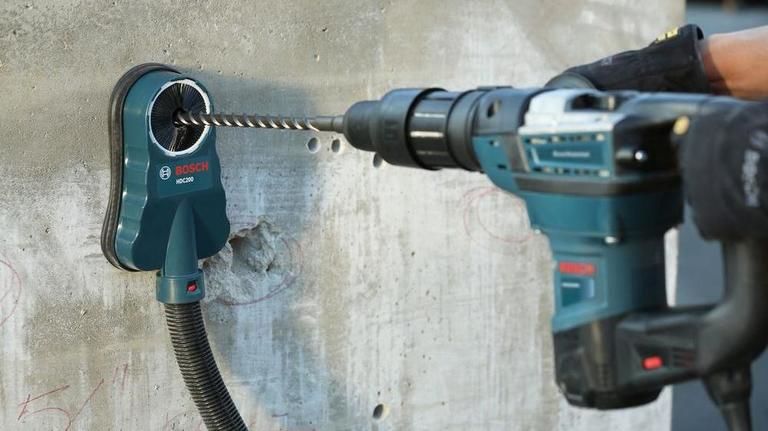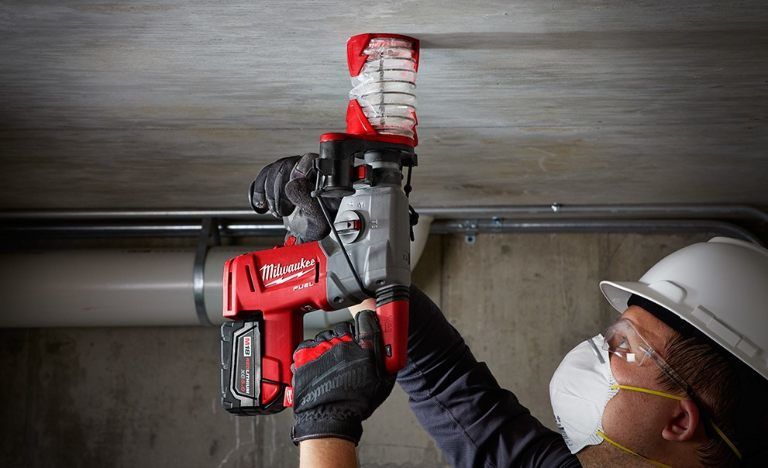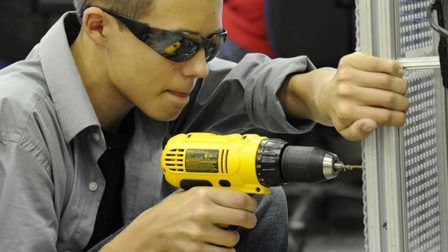The question that is on every drilling professional’s mind: how to reduce dust when drilling? It is also the question for which there does not seem to be an easy, simple answer.
Currently, various methods are employed to reduce dust while drilling, none of which are foolproof.
Unless your power drill supports a vacuum attachment, you have to depend on improvised methods to keep the particles at bay.

But what all can you do to generate less dust and also clean them up after the job is done? Is there a specific way to drill to limit the production of dust? Perhaps the use of a certain drill bit that can reduce accumulation and dissemination of dust, especially coming out of concrete blocks?
Or are there modern, lesser-known ways in which one can prevent the dust from soiling the work area and/or getting into your respiratory system?
These are the questions that we will try to answer today in this post.
This is the article you should be reading to get a quick formal education on the menace of drill dust, how to reduce it, and how to keep it away from your lungs.
Read on…
How to Reduce Dust When Drilling
There are two ways to answer the question that we asked ourselves at the beginning of this article.
The first way (and the more important of the two) is to look at methods that can reduce the creation of dust at the source and collect the dust and debris concurrently at the time of drilling. We will focus more on this and then move to the second part.
The second way is to minimize the dissemination of the dust in and around the job site as well as to prevent it from entering your respiratory system.
For this, we will knock the doors of OSHA, an agency under the US Department of Labor that provides guidelines related to job site safety to workers and employers.
Let’s first look at different methods in which you can reduce dust while drilling.
This is intended directly for professionals, home users, and DIYers.
Dust Extraction at Source
Probably the best way to remove dust when drilling is to use a dust extractor kit.
If your power drill comes with a dust extraction port, using it is a no-brainer as most systems are able to remove 99.9% of dust right at the source.
The working principle is that the extractor is attached at the bottom of the tool with a kettle-like contraption coming out of it. The drill bit usually passes through the end of this contraption which takes in all the dust as it is thrown out of the surface by the bit.

Basically, dust extraction takes place simultaneously as you drill through a concrete wall, thus not allowing the dust to enter the atmosphere.
Most modern extractors, also known as dust vacuums, are extremely efficient when it comes to dust from drilling through mica, concrete, gypsum, and even wood.
Make sure you opt for an M-class dust extractor along with a high-efficiency particular air (HEPA) filter so that you can entrap even the finest dust particles.
Examples of this are Dewalt DWV902M and Makita VC3012M (for both wet and dry dust). Some models come with the vacuum permanently attached to them.
Remember that there is a difference between an extractor and a vacuum. The former will only collect the dust particles while the latter will vacuum it into a pouch. The ideal scenario is a combination of both.
Using a Dust Extractor Drill Bit (Hollow Drill Bit)
This is a special type of drill bit which widens the distance between the person and the dust.
In other words, it does not let the dust particles come in contact with the person drilling the concrete.

The best hollow drills (from brands like Bosch and Fischer) do not let the particles come in contact with even the surrounding air. Such is its efficiency, which is now touted to be the next big thing in reducing dust when drilling.
It employs a simple mechanism. The drill bit is a hollow and long cylindrical structure that resembles an ordinary bit but just a little bigger.
Towards the chuck end is an opening which is in the form of a port. This port can be directly connected to a dust extractor or a vacuum machine. The impact site of the drill bit has a wider opening than its regular diameter, thus not allowing the dust particles to spread out through the gaps.
As the bit bores into the material being drilled, it sends the particles through the hollow structure towards the port which transfers them right into the extractor or vacuum pouch.
A very handy and easy tool for professionals, it is slowly replacing the dust extractor kit.
Water Sprays
This was originally used in metal cutting where workers would keep a source of running water along the cutting action to reduce heat and friction.
In our field of work, a water gun – usually aimed right at the point of impact to demobilize the dust particles – is a moderately effective way of keeping the dust at bay.
The only drawback is that it has the potential to mess up the work area if there is no proper setup to contain the flowing water.
Ventilation
This is more of a complementing method than a standalone one. Increasing the ventilation in a work area – especially in walled rooms – reduces the concentration of silica crystalline particles. But the danger is still out there.
Substitution with Less Hazardous Materials
This is a long shot but still a nice idea.
If you are a construction contractor who has a say in the materials being used to build walls and ducts and ceilings, suggest using less hazardous materials i.e. alternatives to concrete. Anything that does not contain sand is a good alternative.
This way when the need for drilling arises, you have to worry less about the dust particles.
Using a Dust Bowl
When drilling in ceilings, the best way to reduce dust (by collecting it) is to use a dust bowl.

It is attached to the opposite end of the drill bit tip through its center, which then collects all the debris and dust. While this is not as effective as dust extraction, it does prevent spreading of dust into the surrounding air.
Alternatives are Styrofoam cups and DIY paper cones.
Controlled Drilling
In a study published in the International Journal of Coal Science and Technology in 2016, there is a finding about how controlled drilling – proper and minimal penetration, proper rotational rate, proper torque – can generate less fine rock dust, thus minimizing the danger.
As experts in this field, we recommend individuals to learn the art of drilling properly before getting into the field. The right way of drilling can itself act as the first step in reducing dust when drilling.
Using a Sticky Note and Tape
This is the most basic and the least effective method. Bend a sticky note into half and use non-sticky duct tape to paste the note right below the impact point of the drill.
What this will do is collect the larger debris and dust particles so that the floor does not become a mess.
It does nothing to prevent particles from entering your respiratory system, which is why full PPE is absolutely essential.
A Wet Cloth
Place a soaked cloth on the floor right below the impact point to collect the debris and dust particles when drilling.
While this does not prevent the particles from flying either, it helps you easily clean up the mess afterward.
Don’t Overdo
Especially applicable to home users and DIYers, the best trick that you can follow is of not overdoing the drilling.
Tips to Prevent Dust from Entering Your System
The first step is to gear up before entering a job site. The usage of personal protective equipment (PPE) or respiratory protective equipment (RPE) is usually the most critical element of safe and secure workplace practice.
If the contractor is not bothered to ensure that his workers are wearing high-rated PPE, he may be liable to legal actions.
Nonetheless, it is up to individuals to ensure that they enter hazardous work areas only after they have protected themselves with suitable gear.

According to the US Department of Labor, disposable full-body, work-only clothes, goggles, hard hats, hand gloves, and respirators are a must.
Apart from the methods mentioned in the above two sections, you should also take a strong interest in the guidelines laid out by your contractor, employer, and site manager.
If you are part of a union or an association, seek out the guidelines outlined by respective health safety bodies pertaining to your county or state.
Suggestions from OSHA
The Occupational Safety and Health Organization (OSHA) has suggested a few ideas on how workers can protect themselves from concrete and other types of harmful dust.
It has also established Permissible Exposure Limit (PEL), the upper limit (50 micrograms per cubic meter of air over an eight-hour shift) of airborne crystalline silica that workers may be exposed to at a given job site. You may go through the regulation in detail here.
A list of safe practices to avoid dust when drilling:
- Avoid smoking at the job site, which is known to aggravate the issue
- Also avoid tobacco and related products including cosmetic materials
- Know the materials being worked on
- Participate in air monitoring programs
- Wear respirators while working (type CE positive pressure abrasive blasting respirators are recommended; or a respirator approved for protection against crystalline silica-containing dust will also do)
- Keep a pair of disposable or washable clothes to be used only at the job site
- Shower before and after (if possible) entering and leaving the job site
- Avoid eating while working
Essentially, these tips act as complementary to the aforementioned methods. The best way to tackle the issue of dust is to follow every single safety mandate that is allowed by your specific work condition.
In order to be OSHA-compliant, you will need the following:
- An SDS+ or SDS Max drill
- A dust extraction drill bit
- HEPA dust extraction + filter
Why Protect from Dust?
We all know how harmful dust can be to the human body. Studies have proven that dust particles can have adverse effects on lungs, which can further lead to silicosis, an untreatable disease common amongst construction workers.
Other major ailments resulting due to inhaling of such dust particles are asthma, lung cancer, and chronic obstructive pulmonary disease (COPD).
The United States Department of Labor defines silicosis as a terminal disease of the lungs that occurs due to the inhaling of dust containing crystalline silica particles (also known as Respirable Crystalline Silica aka RCS), a natural constituent of the earth's crust and a basic component of sand (concrete) and granite.
The extremity of the disease arises from two things: it causes fibrosis or scar tissue formations in the lungs and it is untreatable.
This makes it gravely important for individuals like you who are either end-users of power drills or who employ others at different job sites.
Although safety is often exercised while power drilling with the right use of goggles and gloves, protection from minute dust particles is still something that does not get much attention.
A lot is at stake for professionals who frequently find themselves working at job sites and engage in concrete drilling and cutting.
Another important thing to note here is that it is only years later (when they might be in an altogether different job) that workers realize that they have been diagnosed with silicosis or other lung-related ailments.
This delayed detection adds to the severity of the disease as by the time it is diagnosed it is usually too late for the affected person.
This makes understanding different ways to reduce dust when drilling all the more important.
Final Thoughts
There are just two things you can do to reduce and prevent dust when drilling: employ dust minimizing techniques as outlined above and wear full body and respiratory protective gear.
Being cognizant of the dangers of fine dust and your own responsibility at protecting your health should push yourself to put safety first over deadlines.
That concrete wall at the job site may need a drilling tomorrow, but it should be your own conscience that tells you that drilling can wait. First, let’s get the right tools and gears.
We hope this short guide has given you some information to stay updated about the latest methods as well as what is expected of you when you are dealing with dust.


